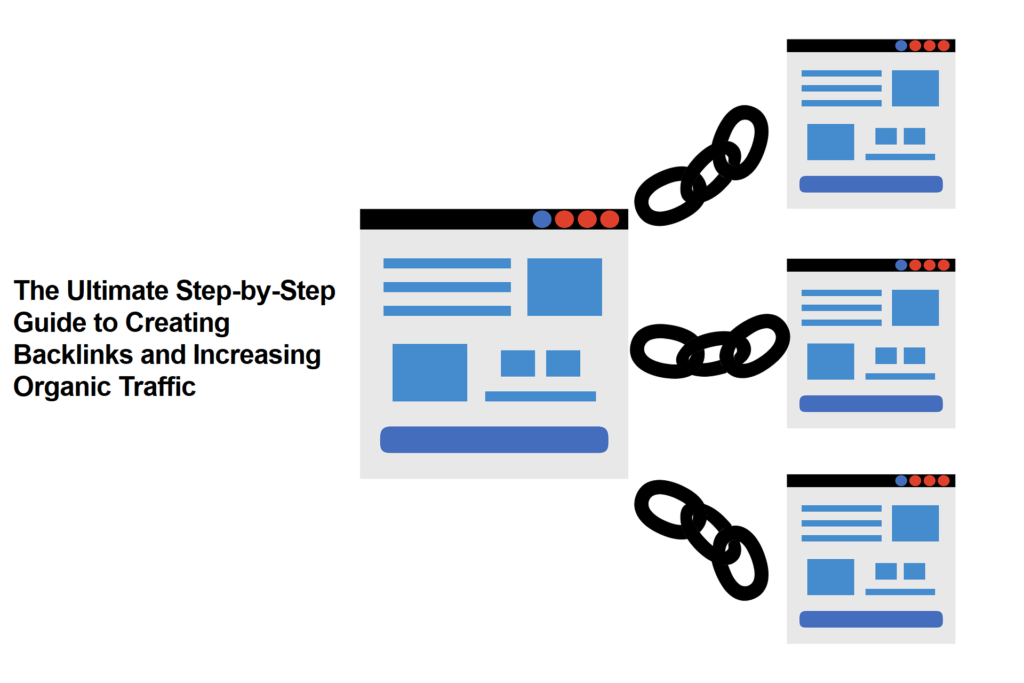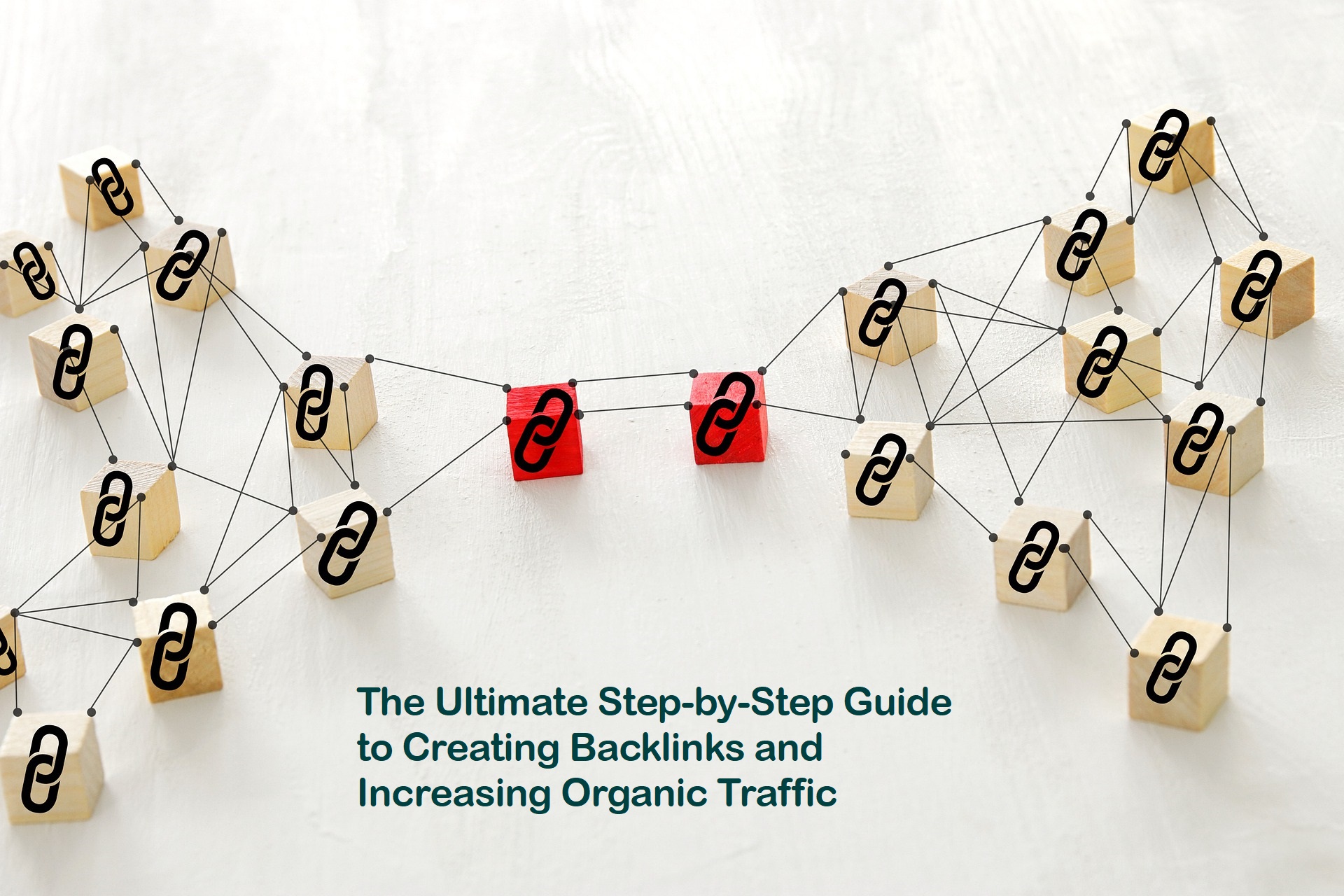The Ultimate Step-by-Step Guide to Creating Backlinks and Increasing Organic Traffic

Introduction
Building backlinks to your website is crucial for improving its visibility in search engine rankings and driving organic traffic. In today’s digital landscape, where competition for online visibility is fierce, having a strong backlink profile is a key factor in gaining an edge over your competitors. Backlinks serve as endorsements from other websites, indicating to search engines that your content is valuable and trustworthy. When reputable websites link to your site, search engines view it as a vote of confidence, resulting in higher rankings and increased organic traffic.
In this comprehensive step-by-step guide, we will explore effective strategies to create backlinks and boost your website’s organic traffic. By implementing these strategies, you can enhance your website’s online presence, attract a larger audience, and ultimately improve your business’s visibility and profitability.
Step 1: Know Your Target Audience and Niche
Identifying your target audience and understanding your niche is a fundamental first step in building a successful backlink strategy. By understanding who your audience is, their demographics, interests, and behaviour patterns, you can tailor your content and outreach efforts to effectively reach and engage with them.
Start by creating buyer personas, which are fictional representations of your ideal customers. Consider their age, gender, location, interests, challenges, and goals. This information will help you craft content that resonates with your target audience and attracts their attention.
Understanding your niche is equally important. Research and analyse your industry to identify the key players, trends, and topics that are relevant to your business. This knowledge will enable you to find websites and communities that align with your niche, where you can build valuable backlinks.
To identify relevant websites, use search engines, industry directories, and social media platforms. Look for websites that are authoritative, have a strong online presence, and attract a substantial audience. Additionally, consider joining industry-related forums and communities where you can connect with like-minded individuals and establish relationships that may lead to backlink opportunities.
Step 2: Create Compelling and High-Quality Content
Producing high-quality and engaging content is one of the most effective ways to attract backlinks naturally. When you provide value to your audience through informative, entertaining, or insightful content, other websites and individuals will be more inclined to share and link to your content.
Start by conducting thorough research on the topics that are relevant to your audience and industry. Look for information gaps or areas where you can provide a unique perspective. Develop a content strategy that addresses these topics and aligns with your target audience’s interests and needs.
When creating content, focus on quality over quantity. Ensure that your content is well-written, well-researched, and provides valuable insights. Use various formats, such as blog posts, articles, case studies, or whitepapers, to cater to different preferences.
Additionally, consider incorporating visual elements, such as images, infographics, or videos, to enhance the appeal and shareability of your content. Visual content tends to attract more attention and is more likely to be shared, increasing the chances of acquiring backlinks.
To further enhance the visibility of your content, optimise it for search engines. Perform keyword research to identify relevant keywords related to your content and industry. Incorporate these keywords naturally throughout your content, including in headings, subheadings, and meta tags. This optimisation will increase the chances of your content ranking higher in search engine results, attracting more organic traffic and potential backlink opportunities.
Step 3: Conduct Keyword Research
Keyword research is a critical step in optimising your content for search engines and increasing its visibility. By identifying the keywords and phrases that are relevant to your content and industry, you can optimise your content to align with what your target audience is searching for.
Start by brainstorming a list of topics and keywords that are directly related to your products, services, or industry. Use keyword research tools, such as Google Keyword Planner, SEMrush, or Moz Keyword Explorer, to expand your list and identify additional relevant keywords. These tools provide valuable insights into search volume, competition, and related keywords.
When selecting keywords, consider their search volume and competition. Aim for keywords with a moderate search volume and relatively low competition to increase your chances of ranking higher in search engine results.
Once you have identified your target keywords, strategically incorporate them into your content. However, ensure that the integration is natural and doesn’t compromise the readability or flow of your content. Search engines value content that is valuable and user-friendly, so avoid keyword stuffing or over-optimisation.
In addition to optimising your content, consider using keywords in your website’s meta tags, URLs, and image alt tags. These elements provide additional signals to search engines about the relevance and topic of your content.
Continuously monitor and analyse the performance of your keywords using tools like Google Analytics. This will help you identify which keywords are driving the most traffic and conversions to your website. Based on this data, refine your keyword strategy and make adjustments as needed to optimise your content further.
Step 4: Embrace Guest Blogging
Guest blogging is a powerful technique for building backlinks and establishing your authority in your industry. It involves writing and publishing articles on authoritative websites or blogs in your niche, with a link back to your website.
To get started with guest blogging, research websites or blogs in your industry that accept guest posts. Look for websites that have a strong online presence, high domain authority, and a substantial readership. Consider the website’s audience and ensure it aligns with your target audience.
Once you have identified potential guest blogging opportunities, familiarise yourself with their content guidelines and submission process. Follow these guidelines carefully to increase the chances of your guest post being accepted. Craft well-written and unique articles that offer valuable insights to their readers. Focus on providing actionable information or addressing common challenges faced by the target audience of the website you’re guest blogging for.
When writing your guest post, include a link back to your website within the body of the article or in the author bio section. This link serves as a backlink to your website, driving traffic and improving your website’s visibility in search engine rankings. However, ensure that the link is contextually relevant and adds value to the readers.
Remember, guest blogging is not just about building backlinks; it’s also an opportunity to showcase your expertise and build relationships with industry influencers. Engage with the audience by responding to comments and promoting your guest post across your own social media channels. This will help you expand your reach, attract more traffic, and potentially acquire additional backlink opportunities.
Step 5: Leverage Broken Link Building
Broken link building is a technique that involves finding websites within your niche that have broken links and offering your content as a replacement. This strategy benefits both the website owner, who gets a functioning link, and you, as you acquire a valuable backlink.
Start by identifying websites in your niche that are relevant to your content and have broken links. You can use tools like Check My Links or Broken Link Checker to scan webpages for broken links automatically. Alternatively, manually review the websites for broken links by visiting different pages and checking for any 404 error pages.
Once you have identified broken links, reach out to the website owners or webmasters, notifying them of the broken links you found on their website. Be polite and helpful in your approach, providing the specific URLs of the broken links and suggesting your content as a replacement. Explain how your content adds value and how it can benefit their audience.
When suggesting your content, ensure that it is highly relevant and provides a seamless replacement for the broken link. The more valuable and relevant your content is, the higher the likelihood of the website owner accepting your offer.
In your outreach, include the link to your content and explain why it is a valuable resource for their audience. This increases the chances of the website owner linking to your content as a replacement for the broken link. If successful, you will not only gain a valuable backlink but also potentially drive traffic from the website’s audience.
Step 6: Develop Shareable Content
Creating shareable content is an effective way to attract backlinks and increase your website’s visibility. Shareable content is content that is informative, visually appealing, and provides value to the audience. When people find your content valuable and engaging, they are more likely to share it with others, resulting in more backlinks.
Consider creating visually appealing content formats, such as infographics, videos, or interactive tools. These formats tend to attract attention and are highly shareable across various platforms, including social media.
Infographics are visual representations of information or data that are easy to understand and visually appealing. They condense complex information into visually appealing graphics, making them highly shareable and link-worthy. When creating infographics, ensure that the information is accurate, visually appealing, and branded with your website’s logo or URL.
Videos are another highly shareable content format that can generate backlinks. Create engaging and informative videos that provide value to your target audience. Share these videos on your website and social media platforms, encouraging others to embed them on their websites and link back to your original video source.
Interactive tools or calculators are valuable resources that can attract backlinks and generate traffic. Develop tools that provide practical assistance or solve common problems related to your industry. These tools encourage others to link back to your website as a valuable resource for their audience. To promote your shareable content, optimise it for social sharing. Include social sharing buttons on your website and encourage readers to share your content with their networks. Additionally, actively promote your shareable content on social media platforms, reaching out to influencers and relevant communities to amplify its visibility.
Step 7: Engage in Industry Forums and Communities
Active participation in industry forums, communities, and social media groups is an excellent way to build backlinks, establish your authority, and connect with like-minded individuals.
Identify relevant online forums, discussion boards, and communities where your target audience and industry professionals gather. Join these platforms and contribute meaningfully to the discussions by providing insightful answers, sharing expertise, and offering valuable assistance.
When engaging in forums, establish yourself as an authority in your field by consistently providing valuable and accurate information. Demonstrate your expertise and knowledge by addressing challenges, answering questions, and sharing your unique insights. By establishing yourself as a trusted resource, you increase the likelihood of others seeking your expertise and linking back to your website.
Additionally, forums often allow you to include a link to your website in your forum signature or profile. Ensure that your forum signature or profile includes a concise and compelling description of your website and its value proposition. This encourages other forum members to click on your link and visit your website, potentially leading to backlinks and increased traffic.
Social media platforms, such as LinkedIn, Facebook groups, or Twitter chats, provide additional opportunities to engage with industry professionals and potential backlink opportunities. Participate in relevant discussions, share valuable content, and connect with influencers in your industry. By building relationships with influential individuals, you increase the chances of them naturally linking to your website in their own content or sharing your content with their followers.
Remember to follow the community guidelines, be respectful, and avoid self-promotion or spammy behaviour. Genuine engagement and providing value to the community should be your primary focus.
Step 8: Build Relationships with Influencers
Influencers are individuals who have a significant impact on your industry and a substantial following. Building relationships with influencers can result in valuable backlinks, increased exposure, and access to their audience.
Start by identifying influential individuals in your industry who align with your target audience and have a strong online presence. Research their content, social media profiles, and engagement with their audience. Gain a deep understanding of their interests, preferences, and the type of content they share.
Engage with influencers through social media platforms, commenting on their posts, sharing their content, and providing thoughtful insights. Be genuine and authentic in your interactions, focusing on building a relationship based on mutual respect and shared interests.
Look for opportunities to collaborate on content projects or provide influencers with exclusive insights or data related to your industry. This collaborative approach strengthens your relationship and increases the likelihood of them linking to your website or sharing your content with their audience.
When reaching out to influencers, personalise your communication and clearly articulate how collaborating with you or linking to your website can benefit them and their audience. Emphasise the value you can provide and how it aligns with their goals and interests.
Building relationships with influencers takes time and effort, but the rewards can be significant. A single backlink from an influential individual can result in a substantial increase in traffic and exposure for your website.
Step 9: Seek Link Opportunities
Research websites that have mentioned your brand, products, or services without linking back to your site. These unlinked brand mentions present an opportunity to reach out to the website owners and request a link.
Start by using search engines or tools like Google Alerts to monitor mentions of your brand, products, or services online. Identify websites or articles that mention your brand but have not included a link back to your website.
Once you have identified unlinked mentions, reach out to the website owners or authors in a friendly and personalised manner. Express your appreciation for the mention and politely request a link to your website. Provide additional information or resources that make it convenient for them to link to your website.
When reaching out, emphasise the value and relevance of your website to their audience. Explain how the link can provide additional context or resources for their readers. By highlighting the mutual benefit of linking to your website, you increase the chances of them adding the link.
It’s important to note that not all website owners will respond or add the link. Be prepared for potential rejections and respect their decision. However, by actively seeking link opportunities, you can increase your chances of acquiring valuable backlinks and improving your website’s visibility.
Step 10: Monitor and Disavow Low-Quality Backlinks
Regularly monitoring your backlink profile is essential to maintain a healthy and high-quality link profile. Low-quality or spammy backlinks can harm your website’s reputation and rankings, so it’s crucial to identify and disavow them.
Use tools like Google Search Console, Ahrefs, or Moz to monitor your backlinks. These tools provide insights into the quality of your backlinks, including their source, domain authority, and spam score.
Review your backlink profile and identify any links from low-quality or irrelevant websites. Low-quality websites include those with poor domain authority, high spam scores, or unrelated content. Such links can negatively impact your website’s SEO performance and should be disavowed.
To disavow a backlink, create a disavow file containing the URLs of the backlinks you want to disavow. Submit this file through Google Search Console or the disavow tool provided by other search engines. This signals to search engines that you don’t want these low-quality backlinks to be considered when assessing your website’s authority and relevance.
Regularly monitor your backlink profile and update your disavow file as needed. This proactive approach helps maintain a healthy backlink profile and ensures that your website’s reputation and rankings are not compromised by spammy or low-quality backlinks.
Summary
Building backlinks and increasing organic traffic requires a strategic and systematic approach. By knowing your target audience, creating valuable content, and engaging with relevant communities, you can gradually enhance your website’s visibility, drive organic traffic, and improve your search engine rankings.
Remember, the key to successful backlink building is to focus on quality, relevance, and ethical practices. Avoid spammy tactics or acquiring low-quality backlinks that may harm your website’s reputation. Instead, prioritise building relationships, providing value, and earning backlinks naturally through valuable content and genuine engagement.
Implement the step-by-step strategies outlined in this guide, adapt them to your specific industry and target audience, and consistently monitor and optimise your backlink profile. With patience, persistence, and a commitment to ethical practices, you can effectively build backlinks and boost your website’s organic traffic.

